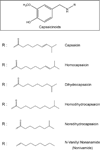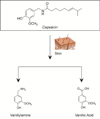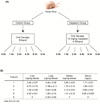Bioavailability of capsaicin and its implications for drug delivery
- PMID: 25307998
- PMCID: PMC4267963
- DOI: 10.1016/j.jconrel.2014.09.027
Bioavailability of capsaicin and its implications for drug delivery
Abstract
The dietary compound capsaicin is responsible for the "hot and spicy" taste of chili peppers and pepper extracts. It is a valuable pharmacological agent with several therapeutic applications in controlling pain and inflammation. Emerging studies show that it displays potent anti-tumor activity in several human cancers. On a more basic research level, capsaicin has been used as a ligand to activate several types of ion-channel receptors. The pharmacological activity of capsaicin-like compounds is dependent on several factors like the dose, the route of administration and most importantly on its concentration at target tissues. The present review describes the current knowledge involving the metabolism and bioavailability of capsaicinoids in rodents and humans. Novel drug delivery strategies used to improve the bioavailability and therapeutic index of capsaicin are discussed in detail. The generation of novel capsaicin-mimetics and improved drug delivery methods will foster the hope of innovative applications of capsaicin in human disease.
Keywords: Bioavailability; Capsaicin; Drug carriers; Metabolites.
Copyright © 2014 Elsevier B.V. All rights reserved.
Conflict of interest statement
The authors declare that they have no conflict of interest.
Figures




References
-
- Govindarajan VS, Sathyanarayana MN. Capsicum--production, technology, chemistry, and quality. Part V. Impact on physiology, pharmacology, nutrition, and metabolism; structure, pungency, pain, and desensitization sequences. Critical reviews in food science and nutrition. 1991;29:435–474. - PubMed
-
- Caterina MJ, Julius D. The vanilloid receptor: a molecular gateway to the pain pathway. Annual review of neuroscience. 2001;24:487–517. - PubMed
-
- Bley K, Boorman G, Mohammad B, McKenzie D, Babbar S. A comprehensive review of the carcinogenic and anticarcinogenic potential of capsaicin. Toxicologic pathology. 2012;40:847–873. - PubMed
Publication types
MeSH terms
Substances
Grants and funding
LinkOut - more resources
Full Text Sources
Other Literature Sources

